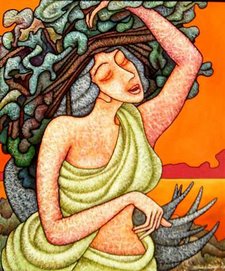
Decided to take a half day tour of Sultanahmet, which included the Hippodrome, the Obelisk, the famous Blue Mosque, and, the equally imposing Haga Sophiya (for reasons that would only be understood by a Bengali, the latter elicited many giggles from my 6 year old!).
The Blue Mosque is one of the most prominent, and, famous, landmarks of Istanbul, and, is very impressive with its beautiful domes, semi domes, courtyards and six minarets. Sultan Ahmet I built the mosque. He ordered Architect Mehmed Aga to build a mosque that would parallel the Haga Sophia - it took around 7 years to build it!
I never realized till I got back that in the construction of the blue Mosque, Mehmet Aga, paid tribute to his colleagues Anthemius of Tralles and Isidorus of Miletus, architects of neighboring Ayasofya (Hagia Sophia), who designed their masterwork a thousand years before Mehmet Aga was born.
The two great buildings, Ayasofya and the Blue Mosque, stand beside one another on the Hippodrome, separated only by a small park. They are both entered from the same direction. In one, the visitor's eye is lifted heavenward inside, in the other, on the outside: master architects conversing across a millennium.
Traditionally, mosques built by Sultans had 4 minarets, and those built by others would have only two, thereby clearly distinguishing mosques built by Sultans / Kings from those built by other noblemen.
As per an anecdote, the 6 minarets of the Blue Mosque were a result of a linguistic misunderstanding! According to it, Sultan Ahmet I wanted to have minarets made of gold which is "altin" in Turkish. The architect misunderstood him as "alti" which means "six" . Luckily for the architect, the Sultant liked the 6 minarets and his head was spared. Prior to that time, no sultan had a mosque with 6 minarets.
As you enter, in the courtyard, there are some fountains which are for people who are going to pray in the mosque. In Islam, prior to praying, one must wash his/her face, arms, neck and feet as well as mouth and nose. This is a basic cleaning, which on the flip side, renders many a public bathroom unusable!
The marble courtyard’s marble comes from the Island of Marmara (the Turkish word for marble ,"Mermer" comes from Marmara).
Upon entering the mosque, one’s head is to be covered, and, the shoes must be taken off and put into plastic bags which one carries in one’s hands. I was amazed to notice that no one forces foreigners to cover their head, though you can buy blue head scarves outside the entrance for 10 TYL. The Turks appear to have great belief in the ability of human beings to pay respect where it is due, and, it’s a belief that’s well placed – you can hear faint murmurs as the guides talk, but no one runs around, screams or makes a nuisance of themselves, unlike in the Valley of the Kings back home.
Upon the entrance to the mosque, one should pay attention to the gate. The gate is a typical Seljuk- Turkish wooden work with a geometrical design in its center. The star symbolizes the Turkish Generation and very typical of early 11-12th C Turkish Art.
As you enter, you look up in awe at the massive interior of the mosque with its chandeliers and blue tiles. The tiles, our guide explained, are all 17th century beautiful Iznik tiles which give the mosque its name.
 The mosque is all carpeted with prayer rugs because people touch their forehead on the ground. The carpet is designed as multiple small rectangles adjacent to each other. Each rectangle indicates a place for one individual to pray.
The mosque is all carpeted with prayer rugs because people touch their forehead on the ground. The carpet is designed as multiple small rectangles adjacent to each other. Each rectangle indicates a place for one individual to pray.Our guide told us that the mosque has 260 windows through which the light sparkles into the mosque. The windows have centuries old stained glass, which diffuses the light as it comes in, and, creates a mellow halo effect.
The pulpit from which the Imam speaks is made of marble. The guide mentioned that every Friday, when the Imam climbs the pulpit for prayers, he never climbs right to the top as a mark of respect to Prophet Mohammed. Everybody turns his or her face to the south when praying, because Mecca( Saudi Arabia) is located in South. At the rear end of the Mosque is a prayer area for women shielded by an intricately worked mashrabeya partition. Some of our co-passengers on the tour, who were Muslims, knelt down to pray.

2 comments:
What an amazing place.
Thanks for sharing.
you are welcome!
Post a Comment